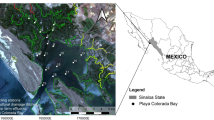Abstract
The visible and infrared bands of Landsat Thematic Mapper (TM) can be used for inland water studies. A method of retrieving water-leaving radiance from TM image over Taihu Lake in Jiangsu Province of China was investigated in this article. To estimate water-leaving radiance, atmospheric correction was performed in three visible bands of 485nm, 560nm and 660nm. Rayleigh scattering was computed precisely, and the aerosol contribution was estimated by adopting the clear-water-pixels approach. The clear waters were identified by using the Landsat TM middle-infrared band (2.1 μm), and the water-leaving radiance of clear water pixels in the green band was estimated by using field data. Aerosol scattering at green band was derived for six points, and interpolated to match the TM image. Assuming the atmospheric correction coefficient was 1.0, the aerosol scattering image at blue and red bands were derived. Based on a simplified atmospheric radiation transfer model, the water-leaving radiance for three visible bands was retrieved. The water-leaving radiance was normalized to make it comparable with that estimated from other remotely sensed data acquired at different times, and under different atmospheric conditions. Additionally, remotely sensed reflectance of water was computed. To evaluate the atmospheric correction method presented in this article, the correlation was analyzed between the corrected remotely sensed data and the measured water parameters based on the retrieval model. The results show that the atmospheric correction method based on the image itself is more effective for the retrieval of water parameters from Landsat TM data than 6S (Second Simulation of the Satellite Signal in the Solar Spectrum) code based on standard atmospheric and aerosol models.
Similar content being viewed by others
References
Chen Chuqun, 1998. Atmospheric correction for red band of ocean colour remote sensing data. Tropic Oceanology, 17(2): 81–87. (in Chinese)
Gilabert M A, Conese C, Maselli F, 1994. An atmospheric correction method for the automatic retrieval of surface reflectances from TM images. International Journal of Remote Sensing, 15(10): 2065–2086.
Gordon H R, Morel A Y, 1983. Remote Assessment of Color for Interpretation of Satellite Visible Image: A Review. New York: Springer-Verlag.
Gueymard C, 1995. Simple model for the atmospheric radiative transfer of sunshine. (SMARTS2) algorithms and performance assessment. Florida: Solar Energy Center.
Hu Chuanmin, Carder K L, Muller-Karger F E, 2000. Atmospheric correction of SeaWiFS image over turbid coastal waters: A practical method. Remote Sensing of Environment, 74: 195–206.
Kaufman Y J, Sendra C, 1988. Algorithm for automatic atmospheric correction to visible and near-IR satellite image. International Journal of Remote Sensing, 9(8): 1357–1381.
Kloiber S M, Brezonik P L, Olmanson L G et al., 2002. A procedure for regional lake water clarity assessment using Landsat multispectral data. Remote Sensing of Environment, 82: 38–47.
Ma Ronghua, Tang Junwu, Dai Jinfang, 2006. Bio-optical model with optimal parameter suitable for Taihu Lake in water colour remote sensing. International Journal of Remote Sensing, 27(19): 4305–4328.
Mayo M, Gitelson A, Yacobi Y Z et al., 1995. Chlorophyll distribution in lake kinneret determined from Landsat Thematic Mapper data. International Journal of Remote Sensing, 16(1): 175–182.
Ouaidrari H, Vermote E F, 1999. Operational atmospheric correction of Landsat TM data. Remote Sensing of Environment, 70: 4–15.
Tang Junwu, Chen Qinglian, Tan Shixiang et al., 1998. Methods of oceanic spectral data measurement and analysis. Marine Science Bulletin, 17(1): 71–79. (in Chinese)
Tang Junwu, Tian Guoliang, Wang Xiaoyong et al., 2004. The methods of water spectra measurement and analysis I: above-water method. Journal of Remote Sensing, 8(1): 37–44. (in Chinese)
Vermote E F, Tanré D, Deuzé J L et al., 1997a. Second simulation of the satellite signal in the solar spectrum, 6S: An overview. IEEE Trans Geosci Remote Sensing, 35(3): 675–686.
Vermote E F, Tanré D, Deuzé J L et al., 1997b. Second simulation of the satellite signal in the solar spectrum (6S): user guide (Version 2), Laboratoire d’Optique Atmosphérique, 1997.7.
Zhang M, Carder K L, Muller-Karger F E et al., 1999. Noise reduction and atmospheric correction for coastal applications of Landsat Thematic Mapper image. Remote Sensing of Environment, 70: 167–180.
Author information
Authors and Affiliations
Corresponding author
Additional information
Foundation item: Under the auspices of National Natural Science Foundation of China (No. 40671138)
Rights and permissions
About this article
Cite this article
Wang, D., Feng, X., Ma, R. et al. A method for retrieving water-leaving radiance from Landsat TM image in Taihu Lake, East China. Chin. Geogr. Sci. 17, 364–369 (2007). https://doi.org/10.1007/s11769-007-0364-7
Received:
Accepted:
Issue Date:
DOI: https://doi.org/10.1007/s11769-007-0364-7




